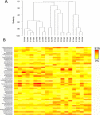Metabolically Active Prokaryotes and Actively Transcribed Antibiotic Resistance Genes in Sewer Systems: Implications for Public Health and Microbially Induced Corrosion
- PMID: 34117524
- PMCID: PMC8195243
- DOI: 10.1007/s00248-021-01775-y
Metabolically Active Prokaryotes and Actively Transcribed Antibiotic Resistance Genes in Sewer Systems: Implications for Public Health and Microbially Induced Corrosion
Abstract
Sewer systems are reservoirs of pathogens and bacteria carrying antibiotic resistance genes (ARGs). However, most recent high-throughput studies rely on DNA-based techniques that cannot provide information on the physiological state of the cells nor expression of ARGs. In this study, wastewater and sewer sediment samples were collected from combined and separate sanitary sewer systems. The metabolically active prokaryote community was evaluated using 16S rRNA amplicon sequencing and actively transcribed ARG abundance was measured using mRNA RT-qPCR. Three (sul1, blaTEM, tet(G)) of the eight tested ARGs were quantifiable in select samples. Sewer sediment samples had greater abundance of actively transcribed ARGs compared to wastewater. Microbiome analysis showed the presence of metabolically active family taxa that contain clinically relevant pathogens (Pseudomonadaceae, Enterobacteraceae, Streptococcaceae, Arcobacteraceae, and Clostridiaceae) and corrosion-causing prokaryotes (Desulfobulbaceae and Desulfovibrionaceae) in both matrices. Spirochaetaceae and methanogens were more common in the sediment matrix while Mycobacteraceae were more common in wastewater. The microbiome obtained from 16S rRNA sequencing had a significantly different structure from the 16S rRNA gene microbiome. Overall, this study demonstrates active transcription of ARGs in sewer systems and provides insight into the abundance and physiological state of taxa of interest in the different sewer matrices and sewer types relevant for wastewater-based epidemiology, corrosion, and understanding the hazard posed by different matrices during sewer overflows.
Keywords: 16S rRNA sequencing; Antibiotic resistance gene transcripts; Sewer microbiome; Sewer resistome; Wastewater-based epidemiology.
© 2021. The Author(s), under exclusive licence to Springer Science+Business Media, LLC, part of Springer Nature.
Conflict of interest statement
The authors delcare no competing interests.
Figures




Similar articles
-
Factors associated with elevated levels of antibiotic resistance genes in sewer sediments and wastewater.Environ Sci (Camb). 2020 Jun 1;6(6):1697-1710. doi: 10.1039/d0ew00230e. Epub 2020 Apr 29. Environ Sci (Camb). 2020. PMID: 34295504 Free PMC article.
-
Sewer biofilm microbiome and antibiotic resistance genes as function of pipe material, source of microbes, and disinfection: field and laboratory studies.Environ Sci (Camb). 2020 Aug 1;6(8):2122-2137. doi: 10.1039/d0ew00265h. Epub 2020 Jun 24. Environ Sci (Camb). 2020. PMID: 33033618 Free PMC article.
-
Prevalence and proliferation of antibiotic resistance genes in two municipal wastewater treatment plants.Water Res. 2015 Nov 15;85:458-66. doi: 10.1016/j.watres.2015.09.010. Epub 2015 Sep 7. Water Res. 2015. PMID: 26372743
-
Microbiome and antibiotic resistance profiling in submarine effluent-receiving coastal waters in Croatia.Environ Pollut. 2022 Jan 1;292(Pt A):118282. doi: 10.1016/j.envpol.2021.118282. Epub 2021 Oct 4. Environ Pollut. 2022. PMID: 34619178 Review.
-
Hospital Wastewater as a Reservoir for Antibiotic Resistance Genes: A Meta-Analysis.Front Public Health. 2020 Oct 28;8:574968. doi: 10.3389/fpubh.2020.574968. eCollection 2020. Front Public Health. 2020. PMID: 33194975 Free PMC article.
Cited by
-
Distinctive microbial community and genome structure in coastal seawater from a human-made port and nearby offshore island in northern Taiwan facing the Northwestern Pacific Ocean.PLoS One. 2023 Jun 9;18(6):e0284022. doi: 10.1371/journal.pone.0284022. eCollection 2023. PLoS One. 2023. PMID: 37294811 Free PMC article.
References
-
- US Centers for Disease Control and Prevention (CDC) (2019) Antibiotic resistance threats in the United States. http://www.cdc.gov. Accessed March 2021
-
- Morales Medina WR, Eramo A, Tu M, Fahrenfeld NL. Sewer biofilm microbiome and antibiotic resistance genes as function of pipe material, source of microbes, and disinfection: field and laboratory studies. Environ Sci Water Res Technol. 2020;6(8):2122–2137. doi: 10.1039/D0EW00265H. - DOI - PMC - PubMed
MeSH terms
Substances
Grants and funding
LinkOut - more resources
Full Text Sources
Medical

